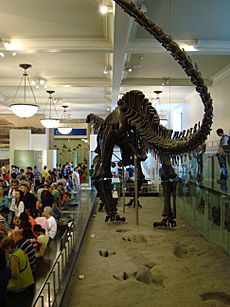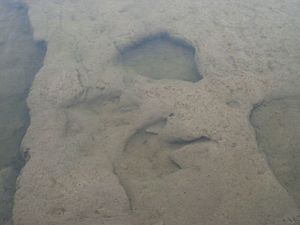Paluxy River facts for kids

The Paluxy River, also called Paluxy Creek, is a river in the U.S. state of Texas. It flows into the Brazos River. The Paluxy River starts where the North Paluxy River and South Paluxy River meet. This is near Bluff Dale, Texas in Erath County. The river flows for about 29 miles (47 km). It joins the Brazos River east of Glen Rose, Texas in Somervell County.
The Paluxy River is famous for something amazing. Many dinosaur footprints have been found in its riverbed. These tracks are near Glen Rose, Texas at Dinosaur Valley State Park. In the 1930s, some people thought they found human footprints next to dinosaur tracks. This caused a lot of discussion. However, scientists later showed that these "human" footprints were either misidentified animal tracks or hoaxes.
Contents
Amazing Dinosaur Footprints
Many dinosaur trackways and footprints have been found in the Paluxy River. Some were discovered as early as 1908. Most of these tracks are in Cretaceous limestone rock. One very famous set of tracks is called the "chase sequence." It shows the footprints of a group of large, long-necked dinosaurs called sauropods. It also shows tracks from at least one meat-eating dinosaur, a theropod, following them.
Scientists believe the sauropod tracks might belong to Sauroposeidon. The theropod tracks are thought to be from Acrocanthosaurus. Other important track sites in the area include the Taylor Site, the Blue Hole Ballroom, and the Blue Hole Parlor. In 1938, a scientist named Roland T. Bird found many tracks in the Paluxy River. His work made the site well-known. It also drew attention from others who mistakenly claimed some tracks were human.
Bringing Dinosaur Tracks to Life Digitally
In 2014, scientists created a digital model of the "chase sequence" trackways. They used old photographs taken by Roland T. Bird in 1940. These photos helped them rebuild the tracks digitally. This was done before the tracks were changed by digging.
The digital model showed how the tracks looked many years ago. It also showed how useful historical photogrammetry can be. Photogrammetry is a way to make measurements from photos. This method helps scientists study old sites and specimens that might have changed over time.
Images for kids
See also
 In Spanish: Río Paluxy para niños
In Spanish: Río Paluxy para niños




